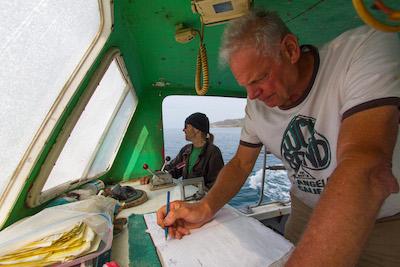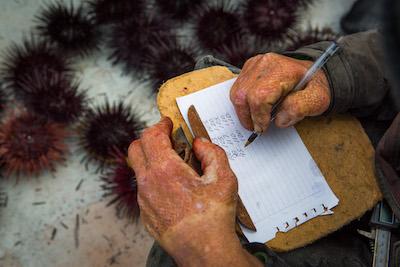Pete Halmay has been diving for California sea urchins for over 40 years. He is also the president of the San Diego Fishermen's Working Group. Here, he remembers in his own words how the fisheries have changed and the role that Sea Grant has started to play in the industry. This is part of a special series celebrating California Sea Grant's 50th anniversary.
“I'm 81 years old now. I'm slowing down but still go diving four days a week. I enjoy it just as much as I always have. On days that I can't go fishing, I don't feel very good.
In my early days, in the mid-1970s, we had 32,000 commercial fishermen in California. Today, there are about 3,000 to 5,000.
I remember vividly when the first Sea Grant advisor started showing up in the 1970s. His name was Art Flechsig. I believe he was an electrician by training. He walked the docks on Thursdays. Or, maybe it was Fridays. Whenever he'd see a fisherman aboard his boat, Art would stop and ask if he had any questions. He had written handouts about types of gear we could use and things like that. This was long before we had email.
Later, it was mostly scientists that came from Sea Grant. I realized that the scientists and us fishermen had to learn a mutual language. With time, we did — and after that, we made real progress. Some became good friends.

Suddenly we had an identity
Fast forward to ten years ago. Sea Grant’s Theresa Talley showed up. Right away she asked, ‘What's important to you fishermen? What can I help with?’ We said direct marketing. At that time, there was no such thing as a fishermen's market. Theresa helped us get the Tuna Harbor Dockside Market in San Diego started. And she did a study because we couldn’t figure out who our customers would be.
We thought we’d make a little more money if we sold directly to the customers. But what we found out is that the fishermen's market sold fishing itself. Local fishing — the idea that it exists, that it’s part of the community. Until then, we sold our product to a wholesaler; they sold it to the consumer. And nobody knew where the fish had come from. Suddenly, we had an identity.
No wholesalers are allowed at the fishermen's market. You can only sell what you’ve caught yourself. You see 20 fishermen coming with 30 to 40 different species that they’ve caught, and all the stories that come with it.
All of a sudden, the Port of San Diego started to take commercial fishing seriously. The legislators thought the market was a fantastic idea because we attracted about 1,000 people down to the docks each week. It became obvious that you actually need the docks, you need offloading facilities, you need processing facilities, you need all that infrastructure.
An apprenticeship for fishing
We also need more fishers. And we need young people. Everybody was always talking about the graying of the fleet. But nobody did anything about it. So Theresa and her counterpart Carrie Culver started working on setting up an apprenticeship program. These programs exist for mechanics or carpenters but not for fishing. Starting one was a big job, and difficult, too. Theresa had to find a school that would teach things like engine maintenance but that wasn’t an expensive four-year program. Because that’s not what fishermen want.
The California Commercial Fishing Apprenticeship Program is working very well. We now have two young guys selling at the fishermen’s market who are a product of this program. And now that we’ve proven that it works it’ll get even better.

One of the big roles I see for Sea Grant is that they don’t just solve the problems of the day but those 10 years from now. Fishermen often don't see five or 10 years down the road. They're consumed with the problems of today and tomorrow. You need people that can step back and start working on something that might become an issue in the future. I like to say that I have 20 years of fishing left. By the time I'm 100, I'm going to quit.
What gives me joy is the freedom that comes with fishing. Everything that bothers you goes away as soon as you untie the boat. You can't think about it if you want to do the job properly. All you concentrate on is where do I go? How am I going to catch my catch?
Fishing also makes you appreciate how grand nature is. I love to see the bottom of the ocean. How it changes. We call it ‘reading the bottom.’ Before you can find out what's good to catch down there you read the bottom. Then you start saying, ‘Hey, why does this look different than it did six months ago or a year ago? Or 10 years ago?’
The biggest issue today is that more and more uses are being placed on the ocean. From aquaculture to wind farms to dumping our sewage into it. Everybody thinks the ocean is limitless. It's not. Somebody's going to have to figure out how to deal with this without destroying our food supply.
We need to place more importance on local seafood as a food source. If we don't have local seafood to feed the community, we're going to be in worse shape than we think we are. To do this, we are going to have to all work together. I don't think Sea Grant can do it by themselves or the fishermen. Only together. Having a doctorate degree doesn't make you better. Having been fishing for 50 years doesn't make you better. But the combination will make both of you great.”
About California Sea Grant
NOAA’s California Sea Grant College Program funds marine research, education and outreach throughout California. Headquartered at Scripps Institution of Oceanography at the University of California San Diego, California Sea Grant is one of 34 Sea Grant programs in the National Oceanic and Atmospheric Administration (NOAA), U.S. Department of Commerce.